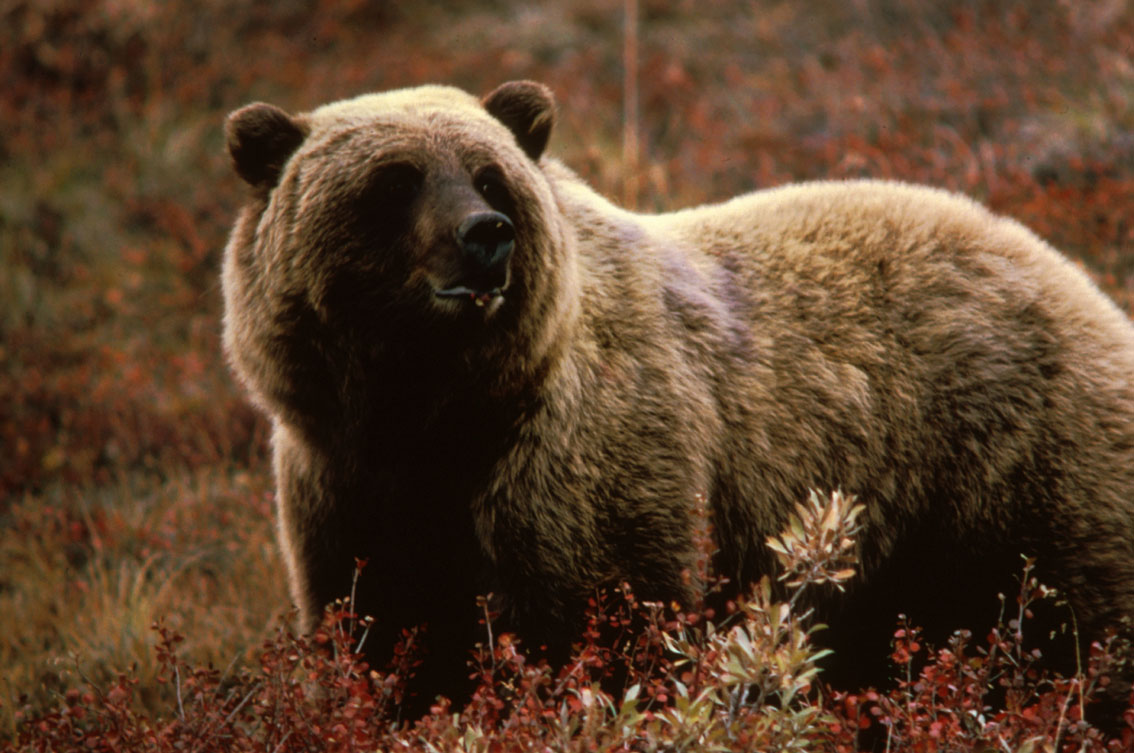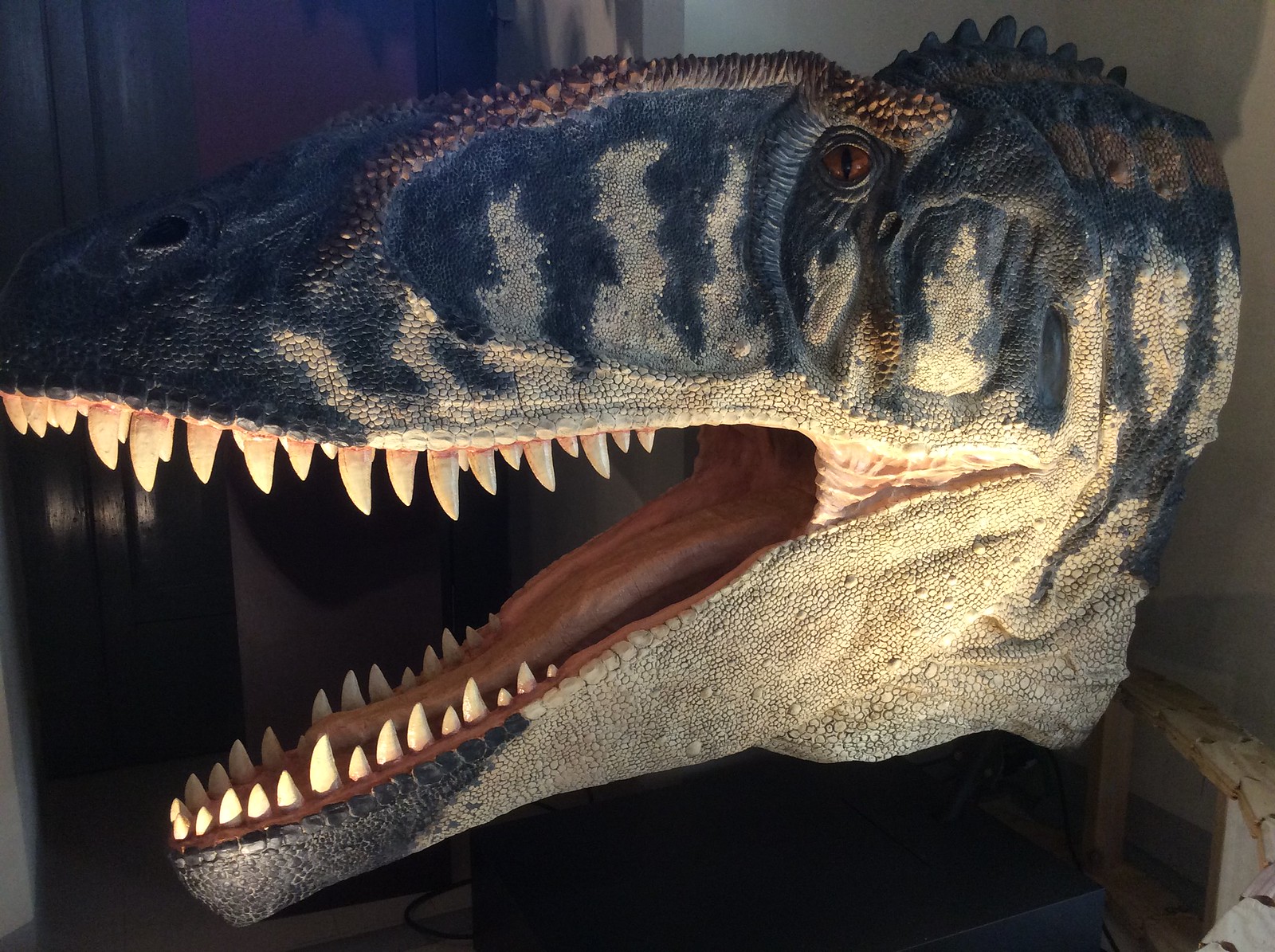Post by Infinity Blade on Jan 25, 2014 19:57:13 GMT 5
Grizzly Bear-Ursus arctos horriblis
The grizzly bear (Ursus arctos ssp.) is any North American subspecies of the brown bear, such as the mainland grizzly (U. a. horribilis), the Kodiak (U. a. middendorffi), the peninsular grizzly (U. a. gyas) and the recently extinct California grizzly (U. a. californicus). Specialists sometimes call the grizzly the North American brown bear because the grizzly and the brown bear are one species on two continents. In some places, some may nickname the grizzly the silvertip for the silvery, grizzly sheen in its fur. Since the mainland grizzly is so widespread, it is representative and archetypal for the whole subspecific group. Even so, classification is being revised along genetic lines. Its closest relatives are the European cave bear and the polar bear. Except for females with cubs, grizzlies are normally solitary, active animals, but in coastal areas, grizzlies gather around streams, lakes, rivers, and ponds during the salmon spawn. Every other year, females (sows) produce one to four young (usually two) which are small and weigh only about 500 grams (1 lb). A sow is protective of her offspring and will attack if she thinks she or her cubs are threatened. Most adult female grizzlies weigh 130–200 kg (290–440 lb), while adult males weigh on average 180–360 kg (400–790 lb). The average total length in this subspecies is 198 cm (6.50 ft), with an average shoulder height of 102 cm (3.35 ft) and hindfoot length of 28 cm (11 in). Newborn bears may weigh less than 500 grams (1.1 lb). In the Yukon River area, mature female grizzlies can weigh as little as 100 kg (220 lb). One study found that the average weight for an inland male grizzly was around 270 kg (600 lb) and the average weight for a coastal male was around 408 kg (900 lb). For a female, these average weights would be 136 kg (300 lb) inland and 227 kg (500 lb) coastal, respectively. On the other hand, an occasional huge male grizzly has been recorded which greatly exceeds ordinary size, with weights reported up to 680 kg (1,500 lb). A large coastal male of this size may stand up to 3 m (10 feet) tall on its hind legs and be up to 5 ft (1.5 m) at the shoulder. Although variable from blond to nearly black, grizzly bear fur is typically brown in color with white tips. A pronounced hump appears on their shoulders; the hump is a good way to distinguish a black bear from a grizzly bear, as black bears do not have this hump.

Postosuchus kirkpatricki
Postosuchus, meaning "crocodile from Post", is an extinct genus of rauisuchian reptiles comprising two species, P. kirkpatricki and P. alisonae, that lived in what is now North America during the Middle and Late Triassic (about 228-202 million years ago). Postosuchus is a member of the clade Pseudosuchia, the lineage of archosaurs that includes modern crocodilians (the other main group of archosaurs is Avemetatarsalia, the lineage that includes non-avian dinosaurs and their descendants, birds). Its name refers to Post Quarry, a place in Texas where many fossils of the type species, P. kirkpatricki, were found. It was one of the apex predators of its area during the Triassic, larger than the small dinosaur predators of its time (such as Coelophysis). It was a hunter which probably preyed on dicynodonts and many other creatures smaller than itself. The skeleton of Postosuchus is large and robust with a deep skull and a long tail. The total body length is about 4 to 5 metres (13 to 16 ft). Although the heavy build of the skeleton suggests that Postosuchus walked on all four limbs, the extreme shortness of the forelimbs relative to the hind limbs is a strong indication that Postosuchus was able to walk on two legs and may even have been committed to bipedal locomotion. Postosuchus was one of the largest carnivorous reptiles during the late Triassic. Adults reached around 4 m (13 ft) in length from snout to tail tip and their mass might have ranged from 250 to 300 kg (550 to 660 lb). It had a massively built skull bearing dagger-like teeth. The neck was elongated, expanding to a short torso and long tail.

The grizzly bear (Ursus arctos ssp.) is any North American subspecies of the brown bear, such as the mainland grizzly (U. a. horribilis), the Kodiak (U. a. middendorffi), the peninsular grizzly (U. a. gyas) and the recently extinct California grizzly (U. a. californicus). Specialists sometimes call the grizzly the North American brown bear because the grizzly and the brown bear are one species on two continents. In some places, some may nickname the grizzly the silvertip for the silvery, grizzly sheen in its fur. Since the mainland grizzly is so widespread, it is representative and archetypal for the whole subspecific group. Even so, classification is being revised along genetic lines. Its closest relatives are the European cave bear and the polar bear. Except for females with cubs, grizzlies are normally solitary, active animals, but in coastal areas, grizzlies gather around streams, lakes, rivers, and ponds during the salmon spawn. Every other year, females (sows) produce one to four young (usually two) which are small and weigh only about 500 grams (1 lb). A sow is protective of her offspring and will attack if she thinks she or her cubs are threatened. Most adult female grizzlies weigh 130–200 kg (290–440 lb), while adult males weigh on average 180–360 kg (400–790 lb). The average total length in this subspecies is 198 cm (6.50 ft), with an average shoulder height of 102 cm (3.35 ft) and hindfoot length of 28 cm (11 in). Newborn bears may weigh less than 500 grams (1.1 lb). In the Yukon River area, mature female grizzlies can weigh as little as 100 kg (220 lb). One study found that the average weight for an inland male grizzly was around 270 kg (600 lb) and the average weight for a coastal male was around 408 kg (900 lb). For a female, these average weights would be 136 kg (300 lb) inland and 227 kg (500 lb) coastal, respectively. On the other hand, an occasional huge male grizzly has been recorded which greatly exceeds ordinary size, with weights reported up to 680 kg (1,500 lb). A large coastal male of this size may stand up to 3 m (10 feet) tall on its hind legs and be up to 5 ft (1.5 m) at the shoulder. Although variable from blond to nearly black, grizzly bear fur is typically brown in color with white tips. A pronounced hump appears on their shoulders; the hump is a good way to distinguish a black bear from a grizzly bear, as black bears do not have this hump.

Postosuchus kirkpatricki
Postosuchus, meaning "crocodile from Post", is an extinct genus of rauisuchian reptiles comprising two species, P. kirkpatricki and P. alisonae, that lived in what is now North America during the Middle and Late Triassic (about 228-202 million years ago). Postosuchus is a member of the clade Pseudosuchia, the lineage of archosaurs that includes modern crocodilians (the other main group of archosaurs is Avemetatarsalia, the lineage that includes non-avian dinosaurs and their descendants, birds). Its name refers to Post Quarry, a place in Texas where many fossils of the type species, P. kirkpatricki, were found. It was one of the apex predators of its area during the Triassic, larger than the small dinosaur predators of its time (such as Coelophysis). It was a hunter which probably preyed on dicynodonts and many other creatures smaller than itself. The skeleton of Postosuchus is large and robust with a deep skull and a long tail. The total body length is about 4 to 5 metres (13 to 16 ft). Although the heavy build of the skeleton suggests that Postosuchus walked on all four limbs, the extreme shortness of the forelimbs relative to the hind limbs is a strong indication that Postosuchus was able to walk on two legs and may even have been committed to bipedal locomotion. Postosuchus was one of the largest carnivorous reptiles during the late Triassic. Adults reached around 4 m (13 ft) in length from snout to tail tip and their mass might have ranged from 250 to 300 kg (550 to 660 lb). It had a massively built skull bearing dagger-like teeth. The neck was elongated, expanding to a short torso and long tail.












